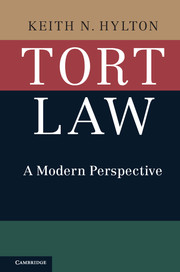Book contents
- Frontmatter
- Contents
- 1 Introduction
- 2 Policy and Tort Law
- 3 Evolution of Tort Law
- 4 Intentional Torts
- 5 Theoretical Foundations of Strict Liability
- 6 The Reasonable Person
- 7 Customs, Statutes, and the Reasonable Person
- 8 Inferring Negligence
- 9 Contributory Negligence and Assumption of Risk
- 10 Contributory Negligence, Comparative Negligence, and Incentives for Care
- 11 Joint and Several Liability, and Vicarious Liability
- 12 Factual Causation
- 13 Proximate Cause
- 14 Duty to Rescue and Special Relationships
- 15 Strict Liability: Conversion, Abnormally Dangerous Activities, and Nuisance
- 16 Defamation
- 17 Products Liability
- 18 Damages
- Index
2 - Policy and Tort Law
Published online by Cambridge University Press: 05 June 2016
- Frontmatter
- Contents
- 1 Introduction
- 2 Policy and Tort Law
- 3 Evolution of Tort Law
- 4 Intentional Torts
- 5 Theoretical Foundations of Strict Liability
- 6 The Reasonable Person
- 7 Customs, Statutes, and the Reasonable Person
- 8 Inferring Negligence
- 9 Contributory Negligence and Assumption of Risk
- 10 Contributory Negligence, Comparative Negligence, and Incentives for Care
- 11 Joint and Several Liability, and Vicarious Liability
- 12 Factual Causation
- 13 Proximate Cause
- 14 Duty to Rescue and Special Relationships
- 15 Strict Liability: Conversion, Abnormally Dangerous Activities, and Nuisance
- 16 Defamation
- 17 Products Liability
- 18 Damages
- Index
Summary
Tort law has been shaped by the policies, often unarticulated, that appear most attractive and persuasive to courts. The two main sources of policies embraced by courts are the fields of economic reasoning and moral reasoning. But there are other sources of policy in addition to these.
Policy rationales can provide either a positive or a normative theory of the law. A positive theory seeks to explain and understand the law as it is. A normative theory seeks to provide a description of an ideal legal system. Positive theories are presented in an effort to provide a deeper understanding of a body of case law. Normative theories, in contrast, are used to criticize existing law and to suggest alternatives, though they sometimes can provide a deeper understanding of the law too. Since this book aims primarily to describe and explain existing tort law, it draws on policy arguments as sources of positive theory for the most part. This chapter surveys the most prominent policies reflected in tort law.
ECONOMIC PRINCIPLES
Economics has increasingly become an important perspective and set of tools to use in analyzing tort law. The reason is easy to see when you examine the cases. Many tort cases involve an explicit tradeoff between costly precautionary effort and risk. The standard example in our lives is driving. A driver can take more precaution by reducing his speed and looking to both sides of the road more frequently. Each time he does so he reduces the likelihood of running into a pedestrian or another car. But each additional precautionary effort costs the driver something – perhaps he arrives to work late as a result.
The tradeoffs tort law grapples with can be classified into two types. One is the tradeoff between instantaneous care and risk. Again, the typical example is driving with more or less care. The other is the tradeoff between activity and risk – that is, doing more or less of an activity, irrespective of how careful you are. For example, even if you are the most careful driver in the world, you can still reduce the risk that you will harm someone by driving less frequently. The first type of tradeoff is described in the economics literature as the care-level decision. The second type of tradeoff is the activity-level decision.
- Type
- Chapter
- Information
- Tort LawA Modern Perspective, pp. 10 - 31Publisher: Cambridge University PressPrint publication year: 2016



